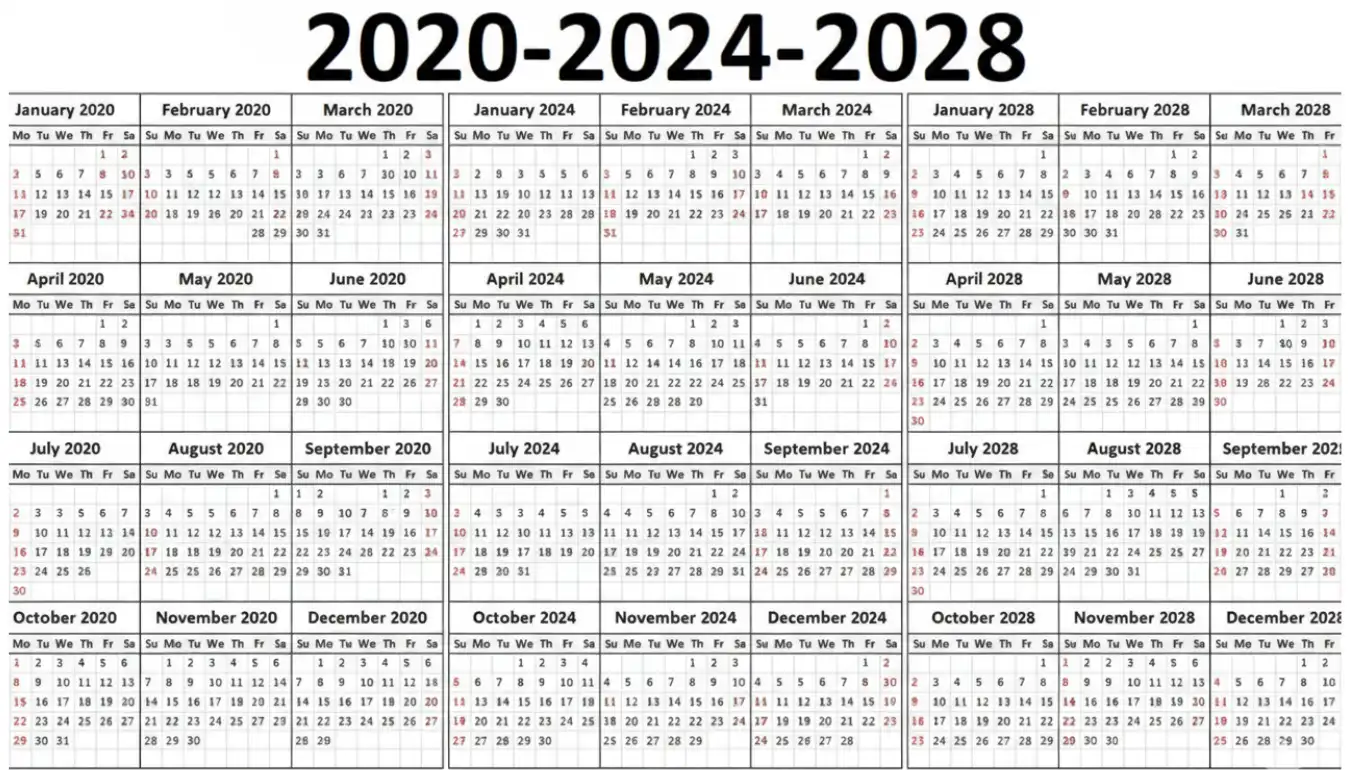
Understanding the Complete Leap Years List
A leap years list is an essential reference tool for anyone working with calendars, dates, or planning long-term events. Whether you’re a developer, historian, or simply curious about when the next February 29 will occur, having access to a comprehensive leap years list can save you time and prevent costly mistakes in date calculations.
The concept of leap years has fascinated humanity for centuries. This extra day added every four years keeps our calendar aligned with Earth’s orbit around the sun. Without leap years, our seasons would gradually shift, and within a few centuries, summer would occur in what we currently call winter months.
In this comprehensive guide, we’ll explore everything about leap years, provide you with complete lists spanning centuries, and help you understand how to calculate and identify leap years for any period you need.
What Makes a Year a Leap Year?
Before diving into the leap years list, it’s crucial to understand the rules that determine whether a year qualifies as a leap year. The Gregorian calendar, which most of the world uses today, follows specific criteria:
The Three Golden Rules
Rule 1: A year must be divisible by 4 to be a leap year.
Rule 2: However, if the year is divisible by 100, it is NOT a leap year.
Rule 3: Unless the year is also divisible by 400, in which case it IS a leap year.
These rules explain why the year 2000 was a leap year (divisible by 400), but 1900 was not (divisible by 100 but not by 400). Understanding these rules is essential when working with any leap years list calculator with dates.
According to NASA’s explanation of leap years, Earth takes approximately 365.25 days to orbit the sun, which is why we need this extra day every four years to maintain calendar accuracy.
Leap Years from 1900 to 3000
| 1904 | 1908 | 1912 | 1916 | 1920 | 1924 | 1928 | 1932 | 1936 | 1940 |
| 1944 | 1948 | 1952 | 1956 | 1960 | 1964 | 1968 | 1972 | 1976 | 1980 |
| 1984 | 1988 | 1992 | 1996 | 2004 | 2008 | 2012 | 2016 | 2024 | 2028 |
| 2032 | 2036 | 2040 | 2044 | 2048 | 2052 | 2056 | 2060 | 2064 | 2068 |
| 2072 | 2076 | 2080 | 2084 | 2088 | 2092 | 2096 | 2104 | 2108 | 2112 |
| 2116 | 2120 | 2124 | 2128 | 2132 | 2136 | 2140 | 2144 | 2148 | 2152 |
| 2156 | 2160 | 2164 | 2168 | 2172 | 2176 | 2180 | 2184 | 2188 | 2192 |
| 2196 | 2204 | 2208 | 2212 | 2216 | 2220 | 2224 | 2228 | 2232 | 2236 |
| 2240 | 2244 | 2248 | 2252 | 2256 | 2260 | 2264 | 2268 | 2272 | 2276 |
| 2280 | 2284 | 2288 | 2292 | 2296 | 2304 | 2308 | 2312 | 2316 | 2320 |
| 2324 | 2328 | 2332 | 2336 | 2340 | 2344 | 2348 | 2352 | 2356 | 2360 |
| 2364 | 2368 | 2372 | 2376 | 2380 | 2384 | 2388 | 2392 | 2396 | 2404 |
| 2408 | 2412 | 2416 | 2420 | 2424 | 2428 | 2432 | 2436 | 2440 | 2444 |
| 2448 | 2452 | 2456 | 2460 | 2464 | 2468 | 2472 | 2476 | 2480 | 2484 |
| 2488 | 2492 | 2496 | 2504 | 2508 | 2512 | 2516 | 2520 | 2524 | 2528 |
| 2532 | 2536 | 2540 | 2544 | 2548 | 2552 | 2556 | 2560 | 2564 | 2568 |
| 2572 | 2576 | 2580 | 2584 | 2588 | 2592 | 2596 | 2604 | 2608 | 2612 |
| 2616 | 2620 | 2624 | 2628 | 2632 | 2636 | 2640 | 2644 | 2648 | 2652 |
| 2656 | 2660 | 2664 | 2668 | 2672 | 2676 | 2680 | 2684 | 2688 | 2692 |
| 2696 | 2704 | 2708 | 2712 | 2716 | 2720 | 2724 | 2728 | 2732 | 2736 |
| 2740 | 2744 | 2748 | 2752 | 2756 | 2760 | 2764 | 2768 | 2772 | 2776 |
| 2780 | 2784 | 2788 | 2792 | 2796 | 2804 | 2808 | 2812 | 2816 | 2820 |
| 2824 | 2828 | 2832 | 2836 | 2840 | 2844 | 2848 | 2852 | 2856 | 2860 |
| 2864 | 2868 | 2872 | 2876 | 2880 | 2884 | 2888 | 2892 | 2896 | 2904 |
| 2908 | 2912 | 2916 | 2920 | 2924 | 2928 | 2932 | 2936 | 2940 | 2944 |
| 2948 | 2952 | 2956 | 2960 | 2964 | 2968 | 2972 | 2976 | 2980 | 2984 |
| 2988 | 2992 | 2996 |
Note: The years 1900, 2100, 2200, 2300, 2500, 2600, 2700, 2900, and 3000 are not leap years.
Leap Years List 1900 to 2100: The Complete Directory
Leap Years List 1900 to 2000
The 20th century contained 24 leap years. Here’s the complete leap years list for this period:
1904, 1908, 1912, 1916, 1920, 1924, 1928, 1932, 1936, 1940, 1944, 1948, 1952, 1956, 1960, 1964, 1968, 1972, 1976, 1980, 1984, 1988, 1992, 1996
Important Note: The year 1900 was NOT a leap year, despite being divisible by 4, because it’s divisible by 100 but not by 400.
Leap Years List 2000 to 2050
For those planning into the near future, here’s the complete leap years list 2000 to 2050:
2000, 2004, 2008, 2012, 2016, 2020, 2024, 2028, 2032, 2036, 2040, 2044, 2048
This list is particularly useful for software developers, project managers, and anyone planning long-term calendars or events.
Upcoming Leap Years List 2025 to 2100
Looking ahead, here’s the upcoming leap years list from 2025 to 2100:
2028, 2032, 2036, 2040, 2044, 2048, 2052, 2056, 2060, 2064, 2068, 2072, 2076, 2080, 2084, 2088, 2092, 2096
Note: The year 2100 will NOT be a leap year, following the same rule that excluded 1900.
Leap Years List 21st Century Complete
The 21st century (2001-2100) will contain exactly 24 leap years, the same as most centuries. Here’s the leap years list 21st century complete:
2004, 2008, 2012, 2016, 2020, 2024, 2028, 2032, 2036, 2040, 2044, 2048, 2052, 2056, 2060, 2064, 2068, 2072, 2076, 2080, 2084, 2088, 2092, 2096
This comprehensive list helps researchers, historians, and planners understand the distribution of leap years throughout our current century.
Leap Years List Next 100 Years
From 2025 to 2125, we’ll experience 24 leap years. The leap years list next 100 years includes:
2028, 2032, 2036, 2040, 2044, 2048, 2052, 2056, 2060, 2064, 2068, 2072, 2076, 2080, 2084, 2088, 2092, 2096, 2104, 2108, 2112, 2116, 2120, 2124
Notice the gap between 2096 and 2104—that’s because 2100 won’t be a leap year.
Complete Leap Years List with Dates: February 29 Through History
Leap Years List with February 29 Dates
When working with a complete leap years list with dates, it’s important to note that February 29 always falls on different days of the week. Here are some notable February 29 dates:
- 2020: Saturday, February 29
- 2024: Thursday, February 29
- 2028: Tuesday, February 29
- 2032: Sunday, February 29
- 2036: Friday, February 29
- 2040: Wednesday, February 29
The day of the week for February 29 follows a predictable pattern based on the leap year cycle and calendar mathematics.
Leap Years List from 1800 to 2200: Extended Historical View
For historians and researchers needing an extended view, here’s a breakdown:
19th Century (1800-1900)
1804, 1808, 1812, 1816, 1820, 1824, 1828, 1832, 1836, 1840, 1844, 1848, 1852, 1856, 1860, 1864, 1868, 1872, 1876, 1880, 1884, 1888, 1892, 1896
Note: 1800 was NOT a leap year.
22nd Century Leap Years (2101-2200)
2104, 2108, 2112, 2116, 2120, 2124, 2128, 2132, 2136, 2140, 2144, 2148, 2152, 2156, 2160, 2164, 2168, 2172, 2176, 2180, 2184, 2188, 2192, 2196
Note: 2200 will NOT be a leap year.
The leap years list from 1800 to 2200 spans 400 years and contains exactly 97 leap years—this is always true for any 400-year period.
Leap Years List Calculator with Dates: How to Calculate
Using a Leap Years List Between Two Dates
When you need to find leap years list between two dates, you can use this simple formula:
Step 1: Start with your beginning year.
Step 2: Check if it’s divisible by 4.
Step 3: Apply the 100 and 400 rules.
Step 4: Move to the next potential leap year (add 4).
Step 5: Repeat until you reach your end year.
For example, finding leap years between 2025 and 2045:
- Start: 2025 (not divisible by 4)
- Next: 2028 ✓
- Then: 2032 ✓
- Continuing: 2036 ✓, 2040 ✓, 2044 ✓
For automated calculations, visit TimeandDate.com’s Leap Year Calculator for instant results or our TOOLXI.COM website
Why Do We Need Leap Years?
The Earth takes approximately 365.2422 days to complete one orbit around the sun. If we only counted 365 days per year, we’d lose about 6 hours annually. Over time, this would cause:
- Seasonal drift: Summer would eventually occur in January
- Agricultural disruption: Planting and harvest seasons would become unreliable
- Cultural calendar misalignment: Holidays and festivals would shift
The leap year system, introduced by Julius Caesar and refined by Pope Gregory XIII, keeps our calendar synchronized with astronomical reality.
Historical Context
The concept of leap years dates back to ancient Rome. Julius Caesar introduced the Julian calendar in 45 BCE, which added one day every four years. However, this overcorrected the problem slightly.
In 1582, Pope Gregory XIII introduced the Gregorian calendar with the 100/400 rule, creating the system we use today. This refinement ensures that our calendar remains accurate for thousands of years.
Practical Applications of a Leap Years List
1. Software Development
Developers frequently use leap years lists when:
- Building date validation systems
- Creating calendar applications
- Calculating age or duration accurately
- Designing scheduling software
2. Financial Planning
Financial professionals need leap years list for:
- Interest calculations over multi-year periods
- Bond maturity date calculations
- Long-term investment projections
- Fiscal year planning
3. Project Management
Project managers benefit from leap years awareness when:
- Planning multi-year projects
- Setting milestone dates
- Calculating project durations
- Scheduling events years in advance
4. Scientific Research
Researchers rely on accurate leap years list for:
- Climate data analysis
- Historical date correlation
- Astronomical calculations
- Geological timeline mapping
Fun Facts About Leap Years
- Leap Day Babies: Only 1 in 1,461 people are born on February 29
- Legal Age: In some countries, leap day babies legally age on February 28 in non-leap years
- Leap Year Capital: Anthony, New Mexico, declares itself the “Leap Year Capital of the World”
- Traditions: In Ireland, women traditionally propose to men on leap days
- Probability: The chance of being born on February 29 is about 0.068%
Myth 1: Every Year Divisible by 4 is a Leap Year
Reality: Years like 1900, 2100, and 2200 are divisible by 4 but are NOT leap years because they’re also divisible by 100 but not by 400.
Myth 2: Leap Years Happen Because Earth’s Orbit Changes
Reality: Earth’s orbit is consistent. We need leap years because we’ve defined a year as 365 days, which doesn’t match Earth’s orbital period.
Myth 3: All Calendars Use Leap Years
Reality: Many calendar systems (Islamic, Hebrew, Chinese) have their own intercalation methods. The leap year concept is specific to solar calendars.
How to Use This Leap Years List
For Personal Planning
- Birthday Planning: If you’re born on February 29, use this list to plan actual birthday celebrations
- Anniversaries: Calculate which anniversaries will fall on a leap year
- Milestone Events: Plan special events that only happen on leap years
For Professional Use
- Database Design: Ensure your systems correctly handle February 29
- Contract Dates: Verify leap year considerations in long-term agreements
- Scheduling Systems: Build calendars that accurately account for leap years
Educational Purposes
- Teaching Tool: Use the leap years list to teach calendar mathematics
- Historical Research: Cross-reference historical events with leap years
- Science Projects: Demonstrate Earth’s orbital mechanics
Advanced Leap Year Calculations
Calculating Leap Years in Any Century
To find the number of leap years in any century:
- Regular centuries (not divisible by 400): 24 leap years
- Century years (divisible by 400): 25 leap years
The 400-Year Cycle
Every 400 years contains exactly 97 leap years:
- 100 years × 4 = 400 potential leap years
- Minus 4 century years = 396
- Plus 1 (divisible by 400) = 397
- Actual formula: 97 leap years per 400 years
This maintains an average year length of 365.2425 days, extremely close to Earth’s actual orbital period of 365.2422 days.
Leap Years in Different Calendar Systems
Julian Calendar
The original Julian calendar simply added a leap day every four years without exception. This system accumulated errors over centuries, leading to the Gregorian reform.
Other Calendar Systems
- Hebrew Calendar: Uses a 19-year cycle with 7 leap months
- Islamic Calendar: Purely lunar, no leap year synchronization with seasons
- Chinese Calendar: Lunisolar with leap months added approximately every 3 years
Frequently Asked Questions
How many leap years are there between 2000 and 2100?
There are 24 leap years between 2000 and 2100. The complete list includes: 2000, 2004, 2008, 2012, 2016, 2020, 2024, 2028, 2032, 2036, 2040, 2044, 2048, 2052, 2056, 2060, 2064, 2068, 2072, 2076, 2080, 2084, 2088, 2092, and 2096. Note that 2100 is NOT a leap year.
Was 2000 a leap year?
Yes, 2000 was a leap year. Although it’s divisible by 100 (which normally makes it NOT a leap year), it’s also divisible by 400, which means it qualifies as a leap year under the Gregorian calendar rules. This makes 2000 a special century year.
What is the next leap year after 2024?
The next leap year after 2024 is 2028. Following that, the subsequent leap years will be 2032, 2036, 2040, and so on, continuing the four-year pattern.
Why was 1900 not a leap year?
1900 was not a leap year because it’s divisible by 100 but not by 400. This is part of the Gregorian calendar refinement that prevents the calendar from drifting over long periods. The same rule applies to 2100, 2200, and 2300.
How do I calculate if a year is a leap year?
To calculate if a year is a leap year: (1) If divisible by 4, it’s usually a leap year. (2) However, if divisible by 100, it’s NOT a leap year. (3) Unless it’s also divisible by 400, then it IS a leap year. For example: 2024 ÷ 4 = 506, so it’s a leap year.
How many leap years occur in 100 years?
In a typical 100-year period, there are either 24 or 25 leap years. If the century year (like 2000 or 2400) is divisible by 400, there are 25 leap years. If not (like 1900 or 2100), there are 24 leap years.
What happens if you’re born on February 29?
People born on February 29, called “leaplings” or “leapers,” typically celebrate their birthday on February 28 or March 1 in non-leap years. Legally, most jurisdictions consider their age to increase on February 28 in non-leap years for official purposes.
Will 2100 be a leap year?
No, 2100 will NOT be a leap year. Despite being divisible by 4, it’s also divisible by 100 but not by 400, so it fails the leap year test. The next century year that will be a leap year is 2400.
Conclusion: Your Complete Leap Years List Resource
Understanding leap years and having access to a comprehensive leap years list is more than just calendar trivia—it’s essential knowledge for accurate date calculations, historical research, and future planning. Whether you need the leap years list 1900 to 2100, want to calculate leap years list between two dates, or simply need to know the upcoming leap years list 2025 to 2100, this guide provides everything you need.
The leap year system represents humanity’s ongoing effort to harmonize our human-created calendars with the natural astronomical rhythms of our planet. Every four years, February 29 reminds us of this elegant mathematical solution to keeping our seasons aligned with our calendars.
For developers, researchers, planners, and curious minds alike, bookmark this leap years list as your go-to resource. Visit ToolXi.com for more calendar tools, date calculators, and time-related resources to help you navigate the complexities of temporal planning.
Remember: the next leap year is 2028, and now you have the complete leap years list to reference for centuries to come!
Lorem ipsum dolor sit amet, consectetur adipiscing elit. Ut elit tellus, luctus nec ullamcorper mattis, pulvinar dapibus leo.

About toolxi.com
Your all-in-one digital toolkit
“Hi, I’m Prachi , creator of toolxi.com…” your free, no-nonsense solution for everyday digital tasks. I’m designed to simplify your workflow with intuitive tools for calculations, PDF manipulation, image editing, text processing, and more. Whether you’re a student, professional, or creator, my goal is to save you time and effort with reliable, browser-based utilities that require zero installation or signup. I’m constantly evolving based on your needs, so feel free to explore and transform how you work online! Try our top tool → Toolxi.com



